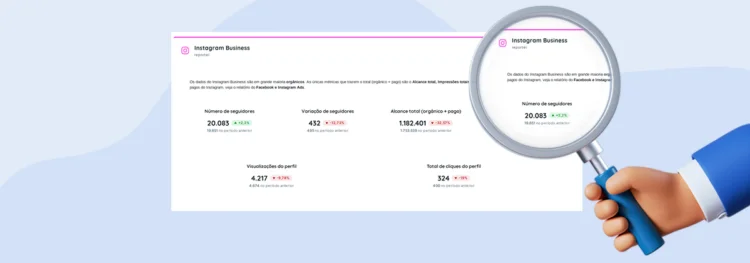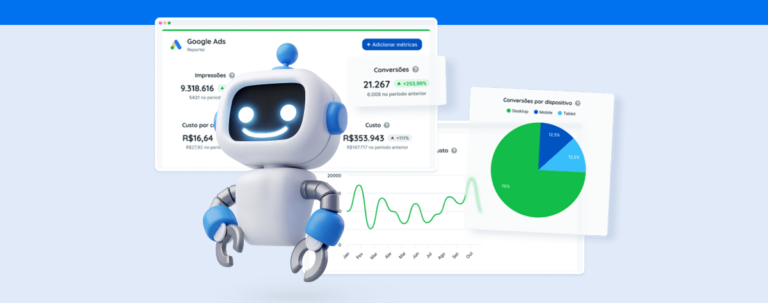Track the most relevant social media metrics for your report and how to conduct a more productive analysis in your routine.
In digital marketing, social media has taken a central role in companies’ communication strategies. With the ability to reach a broad audience and directly interact with consumers, these channels offer fertile ground for business growth.
However, for these platforms to be truly effective, it is essential for companies not only to be present but also to understand the impact of their activities. This is where social media metrics come in, providing valuable insights into campaign performance, audience engagement, and the achievement of set goals.
Therefore, in this article, we will explore the critical metrics that deserve attention in your monthly reports, empowering companies to make informed decisions and optimize their social media strategies for long-term success. Keep reading!
How to Analyze Your Social Media Reports More Productively?
Analyzing social media reports productively requires a structured and targeted approach to extract insights. Below are essential steps to improve your analysis:
- Have specific objectives for your social media activities. Whether to increase brand awareness, generate leads, or boost sales, having clear goals will allow you to assess relevant metrics and the success of your actions;
- Identify relevant metrics that are directly aligned with your objectives. For example, if you aim to generate engagement, metrics like likes, shares, comments, and engagement rates will be crucial. If conversion is the goal, track link clicks, conversions, and conversion rates;
- Follow the context by comparing numbers with previous periods, similar campaigns, or industry benchmarks. This helps understand whether performance is improving or deteriorating and identify possible seasonal patterns;
- Conduct demographic and behavioral analyses to understand who your followers are and how they interact. This helps extract insights about your target audience and refine your strategy to meet their preferences;
- Use analytics tools, such as native platform tools or those that integrate data from all channels into a comprehensive report, like Reportei.
Next, you’ll find out which are the most important metrics to monitor your reach, engagement, and performance of the most popular content on your profile.
Reach Metrics
Reach metrics on social media are crucial for understanding the extent to which your content reaches your target audience, offering insights into the visibility and effectiveness of your posts. Thus, the main reach data you should monitor include:
- The total number of profile followers and those that arrive monthly;
- Total reach and impressions (organic and paid) of your content;
- Total views of your profile;
- Best dates and times to make your posts.
In addition to seeing this information generally, it’s essential to compare them, understand who your followers are, and other aspects that influence your public reach.
By using Reportei to generate your social media reports, for example, you will have access to comprehensive graphs about this information, allowing you to compare them both within the period specified for the report and expand this view to previous months or years.
Engagement Metrics
Engagement metrics on social media are crucial for assessing the interaction and interest your content generates among users, as they indicate the quality of the connection you are establishing with your audience. Therefore, here are some of the key engagement metrics you should monitor:
- Likes, comments, and shares on posts;
- Clicks on links leading to your website or blog and Click-Through Rate (CTR);
- Engagement rate, calculated by summing all likes, comments, shares, and clicks, and dividing that total by the number of impressions for the post (or reach, in some cases). This offers a general view of engagement relative to exposure;
- Video views, if you work with audiovisual content;
- Video retention rate, to measure how many viewers watched the video up to a certain point. This helps identify parts of the video that may be losing audience attention;
- Clicks on interactive elements, such as polls or questions in the content. Monitoring how many users engage with them can indicate the level of involvement and participation;
- Response rate: if you initiate conversations or ask questions in posts, the response rate measures how many users reply. This indicates how willing your audience is to participate in discussions;
- Conversion rate: helps measure how many users took a specific action after interacting with your content, such as making a purchase, filling out a form, or subscribing to an email list.
Tracking these engagement metrics allows you to assess the impact of your content on social media and adjust your strategy to foster a deeper and more meaningful connection with your audience.
Content Performance Analysis
Alongside the analysis of reach and engagement metrics for the account as a whole, it’s also important to evaluate the performance of individual posts. After all, only then can you understand which content is most relevant and make your future planning more efficient.
Reportei features a table of highlighted posts for each channel, listing those with the highest reach, to assist in identifying approaches that work best with your followers.
In the case of the Instagram report, for example, you not only perform a comprehensive analysis of feed content, but also those published in stories and reels.
How to Create Customized Social Media Reports?
Far beyond automatically capturing social media metrics like those from Instagram, Facebook, TikTok, Twitter, and more, you generate customized reports and dashboards according to the needs of your project — which makes it easier for both team analysis and client communication. In this way, you can:
- Determine which data are most relevant to the document, adding or removing metrics as needed;
- Add textual analyses, images, or videos to supplement information captured automatically;
- Change the layout to meet the project’s needs;
- Save the template for use whenever necessary, with the same or different clients.
In short, you have access to all the necessary tools to create efficient social media reports. Take advantage of our 3-day free trial period and discover how to make your analyses more productive with Reportei!





